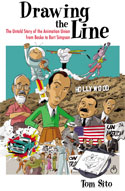|
April 29, 2007 Sunday- Digital's Long Term Storage April 29th, 2007 |
|
Fascinating article from Variety sent to me by Karl Cohen. I recall when the controversy was about modern films done on cheaper 35mm Eastmancolor film stock needed to be rescued while classic Technicolor prints like 1939's Gone With the Wind suffered minimal deteriation. Thanks to Variety for the reproduction.
Digital proves problematic
Industry lacks method to store footage
By DAVID S. COHEN -- "Variety"
As far as movies are concerned, digital, like diamonds, was supposed to
be forever.
No more dyes to fade, no more film stocks to decay or catch fire. Just
pristine digital data, preserved for all time, and release prints as
clear and sharp as the images caught by the camera.
Just one problem: For long-term storage, digital is -- so far --
proving to be a time bomb, more permanent than sand painting but not much else.
Simply put, there's no generally accepted way to store digital
"footage" for more than a few months. After that the industry is using a hodgepodge
of improvised solutions, some rather costly, others not very reliable.
That looked like a small problem when digital filmmaking was limited to low-budget indies, animation houses and tech pioneers like James Cameron and George Lucas.
Now, though, that small problem is growing geometrically as the major
studios shift away from film to digital capture. Such recent releases
as "300," "Apocalypto," "Zodiac" and "Superman Returns" were shot on
digital. Their digital masters could be seriously degraded if the problem isn't
addressed quickly.
In fact, the problem is so severe that the Academy of Motion Picture
Arts & Sciences' Science and Technology Council warned in 2005 that within
just a few years films shot with digital cameras could be lost.
Two years on, digital is going mainstream, but "The problem is still
there," says Phil Feiner, chairman of the Acad Sci-Tech Council's archiving
committee. And those few years the council warned of are nearly up.
It's not that there's no way to store digital data. On the contrary,
there are dozens of ways to store it, most of which go obsolete in just a few
years. Remember 5" floppies and Zip disks?
And the disks that have stuck around? Not so reliable.
Data tapes are balky and can fall apart. Data DVDs and CDs have a history
of "rotting" and can't be counted on to last as long as their commercially
pressed cousins.
Plus there's no reason to expect that the computers of 20 years from
now -- never mind 100 -- will be able to plug in to today's hard disks.Some
private companies are jumping in as awareness of the problem grows, and
Feiner's committee will be launching several initiatives over the months to
come.
But the amount of digital footage that needs to be archived is growing
faster than ever.
More than one tech expert, including the Academy's Sci-Tech Council
director Andy Maltz, told Variety they had found archival tapes unreadable just
18 months after they were made.
Feiner, the former longtime prexy of Pacific Title, says when he worked
on studio feature films he found missing frames or corrupted data on 40%
of the data tapes that came in from digital intermediate houses.
The tapes were only nine months old.
"On certain pictures we had to go into the DI negative and re-scan the
data," he says. "You couldn't retrieve it. Gone."
Milt Shefter, who is a team leader on Feiner's digital archiving
committee, warns that "Long term, it's possible that we're looking going back to
the early days of motion pictures, where films are made, put out for a week
or two, then thrown away."
With acetate or polyester film, the typical approach to archiving has
been summed up as "store and ignore."
Color film can be turned into black-and-white color separations on
polyester stock. Properly stored in cool vaults at low humidity, such film can
last centuries. But there's no way to "store and ignore" digital.
Instead, digital data has to be copied, or "migrated," to new storage
every few years.
Migration, however, takes computers, an IT staff, software and a lot of
labor. In short: money.
While indies may lack the funds to do regular migration, studios are
plunging in.
Sony's VP of asset management and film restoration, Grover Crisp, says
the studio has put in a program of migrating every two to three years.
"The motion pictures and original material, those are primary assets of
the company," says Crisp. "We all want to do whatever we can to protect
those assets."
Disney's VP of production technology Howard Lukk, says as the studios'
digital archives grow, migration becomes a bigger job.
"It's like painting the Golden Gate Bridge and it getting a foot longer
every year."
Not only are more films shot digitally now, but digital filmmaking
encourages directors to shoot more footage.
Mel Gibson told Variety, "Here's the horror. In the average film, it's
900,000 feet to 1.2 million to make a film, roundabout.
"('Apocalypto') was the equivalent of 3 million feet, so it's a lot of
stuff that you don't use but it's recorded."
"The technological issues here are not going to be solved by the
entertainment industry," says Shefter. "It's going to take big
business, big science and maybe big government."
In the meantime, the Academy is stepping in to make the motion picture
industry's voice heard in any big business initiative to solve the problem.
The digital archive project is the broadest initiative launched since
the Acad decided in 2003 to fund the current incarnation of the Science &
Technology Council.
Maltz expects a report that will pin down what the industry needs to do
to be released in a few months.
Meanwhile, private industry is attacking the problem of digital archiving, too, with
at least one announcement in the field planned for NAB.
At NAB, Elektrofilm Digital Studios and Sun Microsystems announced a
service to manage and archive the vast amounts of video from feature film
production.
Many tech experts expect the studios to eventually outsource all their
archiving and migration to companies like Elektrofilm rather than try
to do it themselves. Feiner says what is happening is, in effect, the birth
of a new business: digital archiving.
He speaks from experience. Earlier this year, three companies received
Science & Technology Awards for their work on archiving. Feiner and his
Pacific Title team were among the winners.
Their solution takes the data from a digital intermediate and turns it
into three-color separation negatives.
In other words, they take the digital movie and turn it into good
old-fashioned film.
Read the full article at:
http://www.variety.com/article/VR1117963533.html
---------------------------------------------------------------------------
Birthdays: Emperor Hirohito, Duke Ellington , Duke Wellington, Sir Thomas Beacham, Zuben Mehta is 71, Tom Ewell, Rod McKuen, Fred Zinnemann, Jerry Seinfeld is 52, Michelle Pfeiffer is 49, Daniel Day Lewis is 50, Uma Thurman is 37
1749- In Philadelphia inventor Ben Franklin hosted a dinner party where he used his new battery to electrocute the turkeys to be roasted for the amusement of his guests. .
1771- Artist Benjamin West unveils his painting of the “Death of General Wolfe” at the Royal Academy in London. Wolfe was killed in the Battle of the Plains of Abraham, which decided that Canada would be English. West’s portrayal of Wolfe in his actual uniform instead an idealized Grecian god was considered scandalously realistic and revolutionized painting.
1786- The day before his opera THE MARRIAGE OF FIGARO was to premiere, Wolfgang Amadeus Mozart sat down after dinner and wrote the famous overture. Friends said he liked to think while playing billiards.
1929- The film "All's Quiet on the Western Front" premiered. The world war one battlefield was constructed on a California ranch and dozens of veterans hired to be extras. When the antiwar film debuted in Germany Nazis agitators were sent out to Berlin theaters to release rats, skunks and snakes in the theaters to scare people away. The star of the movie Lew Ayres ruined his career when he declared himself a conscientious objector during World War Two.
1939- It’s strangely ironic that Adolf Hitler’s Government while murdering millions also waged campaigns against cancer and smoking. This day the Nazi Party officially banned smoking in all their offices because of health concerns. The rest of the world wouldn’t even begin to think of linking cancer with cigarette smoking until the 1960’s.
1944- Dancing Romeos, the last Our Gang comedy short was produced by MGM, which had bought the franchise in 1938 from Hal Roach.
1962- President John Kennedy hosted a dinner for a group of Nobel Prize winners at the White House. Kennedy said: “ I think this is the most extraordinary collection of talent and human knowledge that has ever been gathered together at the White House, with the possible exception of when Thomas Jefferson dined alone.”
1992- THE GREAT LOS ANGELES RIOT- Los Angeleanos go berserk after an all white jury in Simi Valley acquitted the policemen who beat up drunk motorist Rodney King in the infamous videotape. 58 killed, 2500 businesses destroyed, $1.5 billion dollars in damage, 13,200 arrests and large sections of Los Angeles put under martial law. Even Rodney King, was moved to go on t.v. and proclaim: " Can't we all just get along ?" Part of the reason the disturbance spun out of control was the hotheaded police chief of the LAPD Darryl Gates was incommunicado for several hours at the beginning of the crisis. He was at a fundraising party in Bel Air to get money to fuel his quarrel with Mayor Tom Bradley -a former LAPD officer. Gates refused to answer the calls of his beleaguered precinct captains. Gates was eventually forced to retire and go on talk shows endlessly defending himself. One irony was the loot-crazed mob ran right past the L.A. County Art Museum to sack a department store on the next corner. I guess they felt that there was nothing of value in it, which is in agreement with many art critics. The Beverly Hills Police, a separate entity, announced they would keep the peace by merely arresting everyone they saw.
2001- Pioneer 10 was a space probe launched to the outer planets in 1972. After sending the first photos of Jupiter and Pluto in 1973 Pioneer 10 left our solar system and headed for deep space in 1997. It’s aimed for the Constellation Taurus. This day 7 billion miles away Pioneer 10 phoned home to say it was fine. It’s last message was received in 2003. I wonder if it asked if Richard Nixon was still president?

|




